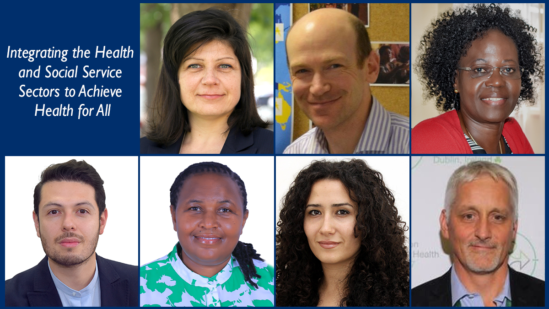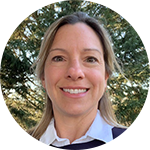
15 Apr How We Can Integrate the Health and Social Service Sectors to Achieve Health for All

Erin Seiler is a senior program manager in Chemonics Global Health Division, supporting the HRH2030 program.
In honor of World Social Work Day, in the International Year of the Health and Care Workers, HRH2030 convened an expert panel to showcase work being done through both global initiatives and country programs, highlighting how the health and social service sectors can better collaborate to achieve success together in improving community health.
Hugh Salmon, Director of Global Social Service Workforce Alliance, set the stage with an inspiring description of the social service workforce. This wide-ranging and inclusive network of professionals work with communities and people of all ages to ensure healthy development and well-being at a range of levels, including workers of social welfare at the macro, mezzo, and micro levels—as well as workers who carry out social service functions who are associated with other allied sectors such as education, health, or justice. Social service workers provide both preventive and responsive services, as well as advocacy for key issues and policy development. They are essential and operate at all levels of society, caring for needs at the micro, mezzo, and macro levels, with individuals, families, and the broader community. Social and health services are at their most effective when care and treatment are combined at the right time in the right place, improving both health and social outcomes. This represents working with a spirit of “Ubuntu,” a focus on the interconnectedness of all peoples and their environment. “Ubuntu: I Am Because We Are,” is the theme of the 2020-2030 Global Agenda for Social Work and Social Development and highlights the need for global solidarity.
Interconnectedness is a key to the success of the USAID MWENDO Orphans and Vulnerable Children (OVC) Project in Kenya, led by Chief of Party Dorcas Amolo, of Catholic Relief Services. Dorcas described the intentional collaboration between MWENDO, the Ministry of Health, and HIV clinical partners to increase access to both health and social services for OVC and their families. They developed a formalized protocol and approach, with bi-directional referrals as the key to their process. OVC partners provide intensive case management at household level, and through referrals, link children and adolescents living with HIV to health care at clinical facilities. At the facilities, health workers will refer and enroll these children into the OVC care services, with the health and social workers joining together to form multidisciplinary treatment teams for case management and HIV treatment, testing, monitoring, and tracing, with recent results showing an increase to 90% having access to viral load testing, and 87% with suppressed viral loads. The success of this approach was shown when the program enrollment scaled up to 51,060 participants—more than four times the number of children and adolescents originally enrolled before this collaborative effort.
Grace Mayanja of FHI360, Chief of Party of the USAID-funded Caring for Vulnerable Children (CVC) Activity in Ethiopia, shared her program’s experiences with the OVC social service workforce’s support for children and adolescents living with HIV. Caring for Vulnerable Children is addressing a recognized and unfulfilled need for socio-economic services for households with children and adolescents living with HIV, to improve their retention in HIV treatment and improve their viral load suppression. The OVC social service cadres conduct case management at the household level and involve families in economic activities. The HIV and health linkage coordinators facilitate bi-directional referrals between health facilities and community-based OVC providers, enrolling OVC who are HIV+ into treatment, and then enrolling them into the OVC program, to support their retention and adherence through case management and comprehensive social services. The program has shown great success by recording 100% retention in treatment of the OVC served in their program (in Q4FY20), with 93% of the children having suppressed viral load. Mayanja stated unequivocally that “the OVC social service cadres do significantly contribute to HIV treatment retention , adherence and VL suppression, and other positive health outcomes for children and adolescents living with HIV and AIDS.”
The social service workforce addresses other health concerns as well as HIV. Alejandro Cáceres, Deputy Director of Juvenile Justice Responsibility at the Colombian Family Welfare Institute (ICBF), an HRH2030 partner, presented new ideas for approaching the population of adolescents and youth committing crimes in the juvenile justice system in Colombia. Data shows that around 90% of the health care needs of youth in the juvenile justice system are mental health related, with 100% of those mental health issues associated with drug abuse. To address this, ICBF created an inter-institutional mental health care approach for youth in the juvenile justice system, who committed crimes while on drugs. Specialized health care focused on detoxification and rehabilitation that includes mental health assistance, is provided to the youth. Additionally, caregivers and professionals in the system are trained on strategies to prevent adverse mental health outcomes on the youth due to the stresses of the juvenile justice system. ICBF continues to advocate for, and develop strategies to promote protective environments, such as long-term follow up with the adolescent and his family, and legal processes for youth, including non-custodial measures, that do not deepen the negative effects on their mental health. This approach, a brilliant example of integrating health treatment and social services, has shown its success by having a recidivism rate more than 20% lower than the recidivism rate of juveniles who are not in this program.
In Armenia, the USAID-funded Community Level Access to Social Services (CLASS) Project, has been engaged in emergency response community social work in an environment of dual crises, war and COVID-19. Aida Muradyan, CLASS Program Manager with World Vision Armenia, described how linking social workers to health workers was crucial in their emergency response, since the health sector had greater access to Armenia’s most vulnerable families. CLASS has worked to grow and develop the capacity of the country’s small cohort of community social workers, from only eight in 2017, to 91 in 2021, by advocating for state reforms on the establishment of community social services positions, developing emergency guidelines and reporting mechanisms for social workers, and advocating for their recognition, social protection, and professional support, and they have succeeded in adding 14 new legal acts regulating the social protection sector. In four years, the number of families who received community social services support increased from 186 to 13,233!
Paul Marsden, Health Workforce Specialist with the World Health Organization (WHO), rounded out the discussion by pulling all these examples into the bigger picture of the WHO’s agenda for strengthening the integration and coordination of, and sustained workforce investments in, essential public health and care services. The WHO vision of an integrated health and social services workforce model works across the community and primary care levels, addressing the needs and perspectives of people and communities front and center. An integrated workforce delivers people-centered care services where, how, and when communities prefer them to be available and accessible. There are community outreach multi-disciplinary teams, operating with intentional collaboration and coordination between health and social services. This workforce will be skilled, empowered, protected, and ready with the best evidence-based guidance, resources, and services to reach the communities they serve. In sum, Marsden said, there can be “no health for all, without an integrated health and social services workforce model.”
In response to a final question posed by the webinar moderator, Wanda Jaskiewicz, Project Director of HRH2030, the panelists highlighted enablers of integration of the health and social services as including, “working backwards,” with an approach that focuses on common and shared outcomes, collaborating holistically to plan and budget together, defining an integrated framework, and understanding the roles of each sector. Recognizing that there is still much work to do to strengthen both the health and social services and workforces, Aida Muradyan concluded with, “Non-cooperation is a luxury we cannot afford as a society.”
Photo: Top row from left to right: Wanda Jaskiewicz of HRH2030, Hugh Salmon of the Global Social Service Workforce Alliance, Dorcas Amolo of CRS. Bottom row from left to right: Alejandro Caceres of ICBF; Grace Mayanja of FHI360; Aida Muradyan, World Vision; and Paul Marsden, of WHO.





